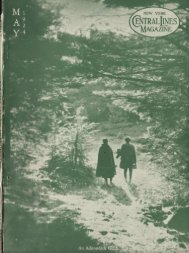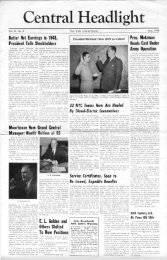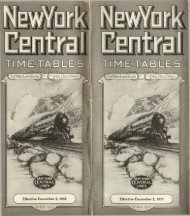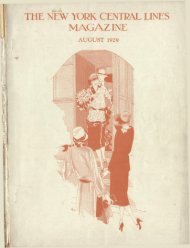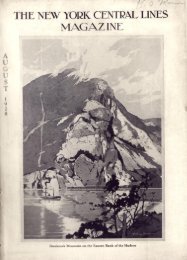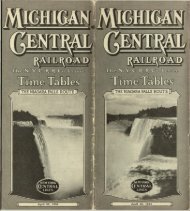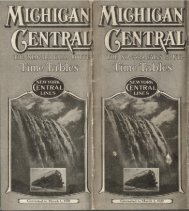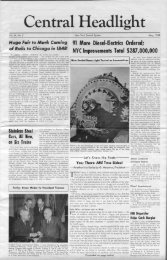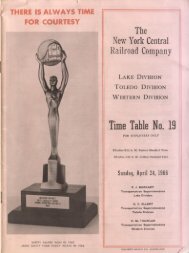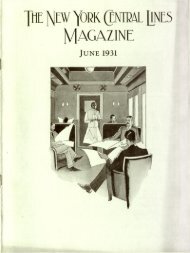Create successful ePaper yourself
Turn your PDF publications into a flip-book with our unique Google optimized e-Paper software.
52<br />
John R. Burke, who has just retired after fifty-five years of railroad service, most<br />
of the time as an engineman for the New York Central, drove the above engine for<br />
six years between Newark and Frankfort, N. Y. The photograph was taken in the<br />
summer of 1888, at Canastota on the Mohawk Division.<br />
A n Eragieemae's M e m o r i e s o f L o n g A g o<br />
DEDICATING his story to the memory of the men he has worked with and<br />
whom he names in his reminiscences, John R. Burke, retiring engineman,<br />
has written for the New York Central Lines Magazine the following<br />
tale of the early days. Among the veteran railroaders vjhom he recalls<br />
are several mentioned by F. A. Chase in the article pn-inted in the December<br />
issue of the Magazine.<br />
Mr. Burke, who began his railroad career fifty-five years ago, starting<br />
with the New York Central eleven years later, came unharmed through the<br />
early days of primitive equipment, and was retired as engineman on the<br />
Syracuse Division early this year.<br />
ORN December 11, 1857, at Au<br />
B burn, N. Y., and brought up there,<br />
I entered the service of the New York<br />
Central Railroad in November, 1872,<br />
on the old Auburn work train.<br />
There was a gang of twenty to<br />
twenty-five men on the train. I did<br />
the same work as the other men, and<br />
received the same wages—$1.50 for<br />
twelve hours' work. I was not yet<br />
fifteen years old, and I never was a<br />
water boy. I flanged the track in<br />
winter with wooden shovels before<br />
there was any such thing as a flanger<br />
car. I picked and shoveled gravel in<br />
Half-Way Gravel Pit before there was<br />
any steam shovel, and more than one<br />
day I had to sit in a snow bank and<br />
eat frozen food when noon-time came.<br />
Dan Shapcott was the engineer<br />
and was also the conductor who hired<br />
and discharged the men, kept the time<br />
of the men and supervised all the<br />
work. His engine was the 206. Our<br />
working territory was from Syracuse<br />
to Geneva. Hank Hall was road master<br />
and he had two brothers—"Ed,"<br />
section foreman at Cayuga, and "O.<br />
J.," conductor of the Canandaigua<br />
work train. Commodore Vanderbilt<br />
was president and William H. Vanderbilt,<br />
his son, was vice-president<br />
then. James Tillinghast was general<br />
superintendent. William G. Lapham<br />
was division superintendent with offices<br />
at Syracuse, and from Syracuse<br />
to Rochester was a division on'both<br />
the main line and Auburn road.<br />
Twenty-five to thirty cars (with not<br />
more than ten tons of freight in each<br />
car) comprised a train in those days.<br />
DeWitt freight yard was not yet<br />
thought of at that time.<br />
By John R. Burke<br />
Henry Ward was station agent at<br />
Auburn in those days, and I succeeded<br />
his son, Kilbourne Ward, as yard<br />
master at Auburn, when he went to<br />
the M.D.T. people at Syracuse.<br />
Coupling Cars at Auburn<br />
In the spring of 1873 I went coupling<br />
cars in Auburn yard with the pin<br />
and link, crooked link and chain link,<br />
and dead blocks, the most dangerous<br />
cars that ever were built. At this<br />
time there were passenger car shops<br />
in Auburn for building and repairing<br />
passenger cars and painting and varnishing<br />
them. The foreman's name<br />
was William Johnson. There also was<br />
a blacksmith shop for mending rails,<br />
as the ends of rails would get battered<br />
down, and then would have to<br />
be taken out and repaired. No steel<br />
rails in those days. Tom Munsell was<br />
boss blacksmith. William B. Munsell,<br />
a son, was pensioned two months ago<br />
in Buffalo, as an engineman. These<br />
shops stood where the freight house<br />
now stands, from Seymour Street to<br />
Chappie Street, and they were built<br />
by the old Auburn & Syracuse Railroad<br />
when John H. Chedell of Auburn<br />
was President. Afterwards consolidation<br />
took place and the line was<br />
called the New York Central.<br />
The Early Passenger Engines<br />
Who is there now that remembers<br />
those passenger engineers of the seventies<br />
that ran over the Auburn road<br />
in the days when I worked with them?<br />
There was Hank Case on engine 194,<br />
John Kinney, fireman; Charley Simonds,<br />
engine 26; Ed Morriott, fire-<br />
New York Central Lines Magazine for May, 1928<br />
man; Bill Pike, engines 57 and 61;<br />
Patsy White, fireman; Dave Cambell,<br />
engines 102 and 535; R. Peters,<br />
fireman; Jack Baker, engine 104;<br />
Charley Chapman, fireman, and Mace<br />
Gibson, engine 68; Tommy Crummy,<br />
fireman, who got killed going down<br />
around the "Alps" one night. His<br />
engine struck a big stone that rolled<br />
onto the track, and he got caught in<br />
the gang-way when engine and tender<br />
came together. Then there was Engineer<br />
Belty, engine 154, who went<br />
down in a washout coming into<br />
Geneva one Saturday night, going<br />
west in March, 1873. Belty and his<br />
fireman got killed. I worked at the<br />
wreck the next day.<br />
Some of the Old-Time Enginemen<br />
I remember Engineer Shafer on engine<br />
327; Charley Thomas, engine<br />
112; Leander Wright, engine 103;<br />
Prank Dana, fireman, and Mike Lynn,<br />
extra passenger engineer of Rochester.<br />
Some of the freight engineers that<br />
I knew in those days-and worked with:<br />
Charley H o g a n<br />
(of 999 fame)<br />
then running engine<br />
410; Joe<br />
L i p e and John<br />
Thompson, engine<br />
403; Bob Shannon,<br />
404; Emps<br />
Belden, 405; Tom<br />
Baker, 409; Ed<br />
McGrale (Stone<br />
Wall), 411; Lute<br />
Eldridge, 413;<br />
Bill Cone, 415;<br />
Jimmy Gould,<br />
320; Johnnie Cof<br />
John R. Burke fee, 323; Dick<br />
Pyles, 299; Cale Cherry, 398; Dick<br />
Bishop, 121; Harry Watkeys, 331;<br />
Jack Mack, fireman; Ben Balbou, 357;<br />
Connie Murphy, 184; Billy Pellynze,<br />
302; Al Pugsley, 353; Billy Owens,<br />
377; Johnnie Cool, 363; Curley Simpson,<br />
344; Billy Emels, 324; Engineer<br />
Bradley, 225.<br />
The first engine that I coupled cars<br />
after was number 107, a wood burner.<br />
Billy Goodwin was engineer. Afterwards<br />
I worked on engines 56, 37<br />
and 130.<br />
The road at this time was going<br />
from wood to coal in the engines, and<br />
wood was being burned in passenger<br />
coach stoves.<br />
On Chicago & North Western<br />
In 1879 I went to the Chicago &<br />
North Western as fireman on the Wisconsin<br />
Division out of Chicago, running<br />
between Chicago and Milwaukee,<br />
Pon du Lac, Oshkosh, Harvard Junction<br />
and Janesville. I was firing three<br />
years and in the spring of 1882 I was<br />
promoted to engineer, and the first<br />
engine I ran was the 284 Mogul road<br />
engine. On December 30, 1884, I<br />
came to the New York, West Shore &<br />
Buffalo as engineer, running between<br />
Buffalo and Syracuse on through<br />
freight. In the spring of 1885 I was<br />
put on through freight between Newark<br />
and Frankfort, a 109-mile run.<br />
In the summer of 1885, I was ordered<br />
to take the pusher engine at<br />
Oneida Castle, and remained there<br />
about eighteen months. I then went<br />
drawing through freight between De-<br />
Witt and Coeymans Junction on the<br />
Mohawk Division. My next run was<br />
New York Central Lines Magazine for May, 1928 53<br />
on a pick-up train between Newark<br />
and Frankfort, then I went drawing<br />
the local freight between Newark and<br />
Syracuse, and after some time I went<br />
drawing fast freight and extra passenger<br />
between Buffalo and Syracuse.<br />
When I left this run I took the yard<br />
job at Newark, with passenger relief<br />
work, and in 1892 was given a regular<br />
passenger train out of Buffalo, but I<br />
did, not take it, as I did not want to<br />
live' in Buffalo.<br />
Two Sons Also in Service<br />
In 1914 I was transferred to Lyons<br />
where I remained until I was pensioned<br />
on January 1. I was railroading<br />
fifty-five years and one month,<br />
forty-five years as locomotive engineman.<br />
My father and three brothers<br />
besides myself have worked for the<br />
New York Central, and I have two<br />
boys who are enginemen at the present<br />
time—Earl and Harold Burke,<br />
running out of DeWitt on the Syracuse<br />
Division. My father worked for<br />
the New York Central thirty-five<br />
years, starting in 1848.<br />
In the December number of the<br />
New York Central Lines Magazine<br />
F. A. Chase, Master Mechanic from<br />
1849 to 1910, speaks of Engineer William<br />
Crealman at Rochester whom I<br />
knew, and I have heard my father<br />
speak of the other engineer, Hank<br />
Bailey, whom Mr. Chase speaks of.<br />
He also speaks of a Mr. Tilton, who<br />
worked with him in the Detroit shops.<br />
George W. Tilton was my superintendent<br />
of motive power while I was on<br />
C. & N. W. and was killed as Mr.<br />
Chase says. Mr. Chase also speaks<br />
of a Mr. Boon who was master mechanic<br />
at Adrian, Mich., when he<br />
worked there. I wonder if that is<br />
not pur James M. Boon, who was superintendent<br />
of motive power of the<br />
West Shore, and located at Frankfort,<br />
N. Y., where the main shops were<br />
located? Mr. Boon was at one time<br />
superintendent of motive power of the<br />
Pittsburgh, Fort Wayne & Chicago<br />
Railroad, and afterwards came to the<br />
Chicago & North Western as assistant<br />
superintendent of motive power under<br />
George W. Tilton, and was there when<br />
I was running on that road, and I<br />
considered him a very able man. It<br />
was at Frankfort that I first met<br />
John Howard, who at that time was<br />
assistant round-house foreman under<br />
Joe Johnson, afterwards becoming superintendent<br />
of motive power of the<br />
New York Central, and a man of<br />
whom I thought a great deal.<br />
Engines Named and Numbered<br />
In my early days on the Auburn<br />
branch of the New York Central quite<br />
a number of the engines retained<br />
their names as well as their number.<br />
I remember the John Wilkinson was<br />
No. 100. The General Gould was the<br />
101. The Young America was 53, and<br />
the John H. Chedell, 54. The C. C.<br />
Dennis was the 26 and the Daniel<br />
Drew was No. 11.<br />
I also knew Bill Gould who ran<br />
engine 125, and Jim Wood who ran<br />
engine 110 on the main line. What<br />
two beautiful looking engines they<br />
were! The clappers in their bells<br />
were "case-hardened" and when the<br />
bells were ringing you would be delighted<br />
to listen to them. I would like<br />
to hear such bells again.<br />
Jim Wood was about the nerviest<br />
engineer in his day on the New York<br />
Central. It was he who always drew<br />
Commodore Vanderbilt and his son,<br />
William H. Vanderbilt, when they<br />
came over the road on the Western<br />
Division. He made the run from<br />
Syracuse to Rochester, eighty-one<br />
miles, in eighty-two minutes one time<br />
before the days of any air brakes.<br />
Nowadays it is consoling to the engineman<br />
to know that he has a powerful<br />
and quick-acting air brake at his<br />
left hand.<br />
The smallest engine I ever saw on<br />
the New York Central was No. 12 at<br />
Auburn. She was a wood-burner and<br />
had only one driving wheel on a side,<br />
and she could only handle four or five<br />
cars at a time with only ten tons of<br />
freight in each car. Billy Goodwin<br />
was the engineer and he had to do his<br />
own firing.<br />
And now I come to the half-way<br />
posts on the Auburn road of the New<br />
York Central.<br />
In my early days there were posts<br />
erected near the side of the track halfway<br />
between stations and they were<br />
called the half-way posts with signs<br />
on them reading "Half-Way."<br />
The time-card rule in those days<br />
Froim Here to Montreal<br />
By Henry Stringham<br />
T matters not where "here" may<br />
I be,<br />
It's just a starting place;<br />
And here or there is equally<br />
A valid homing base.<br />
The way lies through a sheer domain<br />
Of ledges crudely piled,<br />
Contrived by energy amain<br />
Athwart a region wild.<br />
A land of terraced spikes of green<br />
With silver interspersed,<br />
Where hilltops totter and careen<br />
Like giants sore athirst<br />
In search of fiery waters where<br />
But sylvan ripples flow,<br />
The Adirondacks bathe in air<br />
That sundown sets aglow.<br />
The Raquettes and the Saranacs,<br />
The Placids and the Clears,<br />
Are spotlights on the tangled tracks<br />
of roving mountaineers,<br />
Till comes in calm comparison<br />
The Salmon River's vale,<br />
Where meet in friendly garrison<br />
The pixies of the trail.<br />
And so from here to Montreal<br />
One travels through these scenes,<br />
And marvels as the rapids fall<br />
Or as a mountain leans.<br />
And when returned to kin and kith,<br />
With hearts devoid of guile,<br />
Why do our cronies greet us with<br />
That queer, suspicious smile?<br />
said that eastbound trains had the<br />
right of road over west-bound trains<br />
until they were fifteen minutes late.<br />
Then if the west-bound train did not<br />
see the east-bound coming, it would<br />
pull out against the other without any<br />
orders whatever, and the train that<br />
got to the half-way post first was the<br />
best man.<br />
The other train had to back up to<br />
the next station. Of course if the<br />
east-bound engineer was running late<br />
he would expect the west-bound pulling<br />
against him, and I have seen the<br />
time where both engineers would see<br />
the other one coming, but would still<br />
keep moving toward the post, and I<br />
have seen where one would beat the<br />
other by the length of his pilot. I<br />
have seen the engineer of the westbound<br />
send a brakeman out on the<br />
front end of the engine, and hold a<br />
coat over the headlight, so that the<br />
other engineer would not see him coming<br />
until he got near the post. There<br />
were no air brakes in those days, all<br />
hand brakes, and in a movement of<br />
this kind every man was at his post,<br />
and I never heard of any accident<br />
happening.<br />
Every Man to His Own Engine<br />
Telegraph offices in those days were<br />
not as close as at the present time,<br />
and it would be from some station<br />
where there was no telegraph office<br />
that such movements would take<br />
place. In the daytime the engineer<br />
would watch for the smoke of the<br />
other fellow, and for his headlight at<br />
night. Back in those days Skaneateles<br />
Junction, Auburn, Cayuga, Geneva,<br />
and Canandaigua were wood stations,<br />
brought there by wood contractors.<br />
Back in those days every engineer<br />
had a regular engine, and no one ran<br />
her but the regular assigned engineer.<br />
There were no injectors in those days<br />
that you could depend on. Every engine<br />
had two pumps, one on each side,<br />
to put water in the boiler when the<br />
engine was moving. Engineers had to<br />
pack their own pistons, valve stems<br />
and pumps, also all cocks in cab, and<br />
take care of the headlight.<br />
I have run under Superintendents<br />
D. B. McCoy, James P. Bradfield, C.<br />
H. Ketchum, F. W. Everett, and M.<br />
E« Walsh. The master mechanics<br />
were T. W. Fredericks, George W.<br />
West, James McBeth, P. E. Garrisson,<br />
and Charley Hogan at Buffalo, and<br />
James M. Boon, and John Howard at<br />
Frankfort on the Mohawk Division.<br />
W. J. Crandall of Rochester, N. Y.,<br />
was my last master mechanic.<br />
In conclusion, I want to say that I<br />
hold the deepest respect and greatest<br />
admiration for the superintendents<br />
and master mechanics under whom it<br />
has been my privilege to work. I always<br />
tried to do the best work that<br />
was in me for the Company. I have<br />
always considered the officials of the<br />
New York Central Railroad to be real<br />
men of the finest type, and I am proud<br />
today to be numbered among those<br />
who form that great family known as<br />
the New York Central Railroad.<br />
I would be pleased to hear from any<br />
of my friends, young and old, at my<br />
home, 317 Colton Avenue, Newark,<br />
Wayne County, N. Y.





